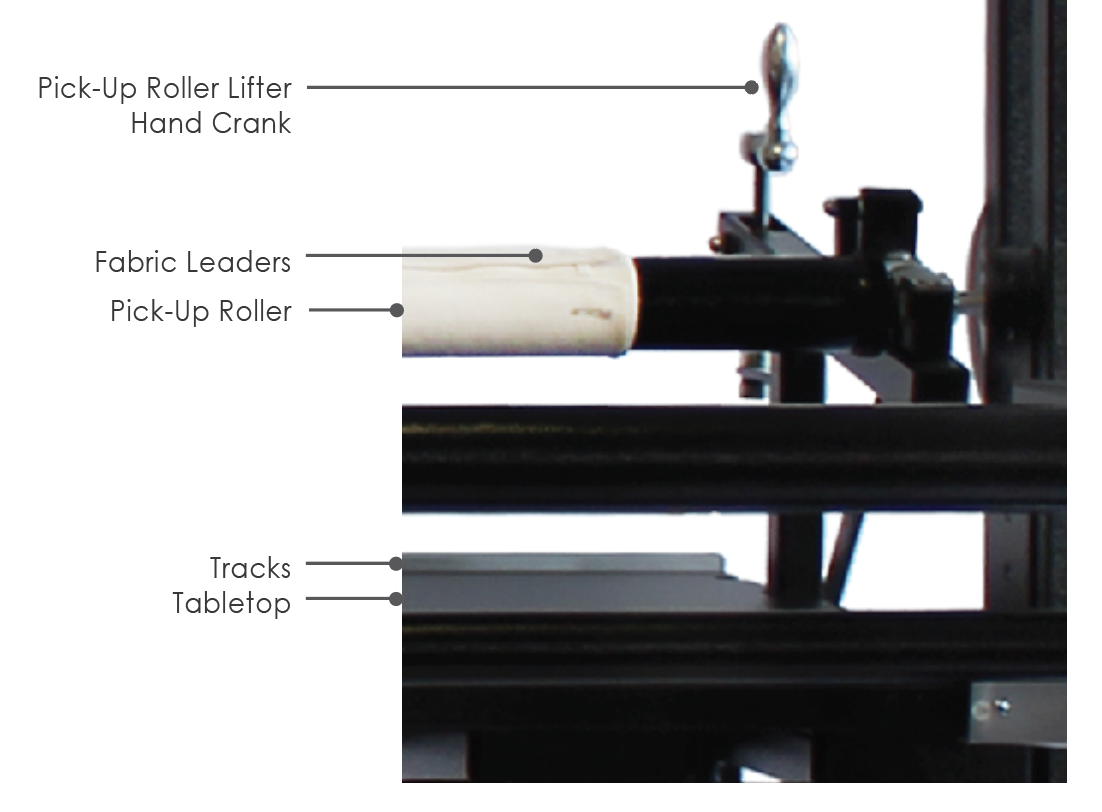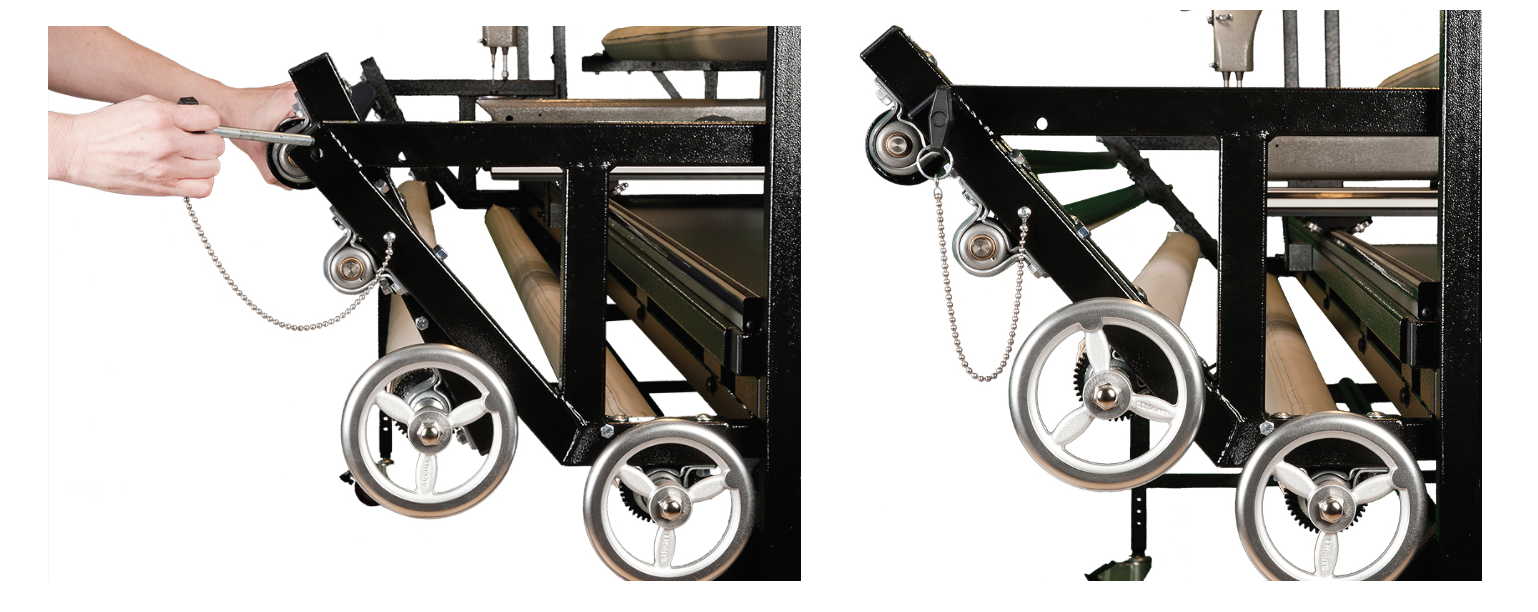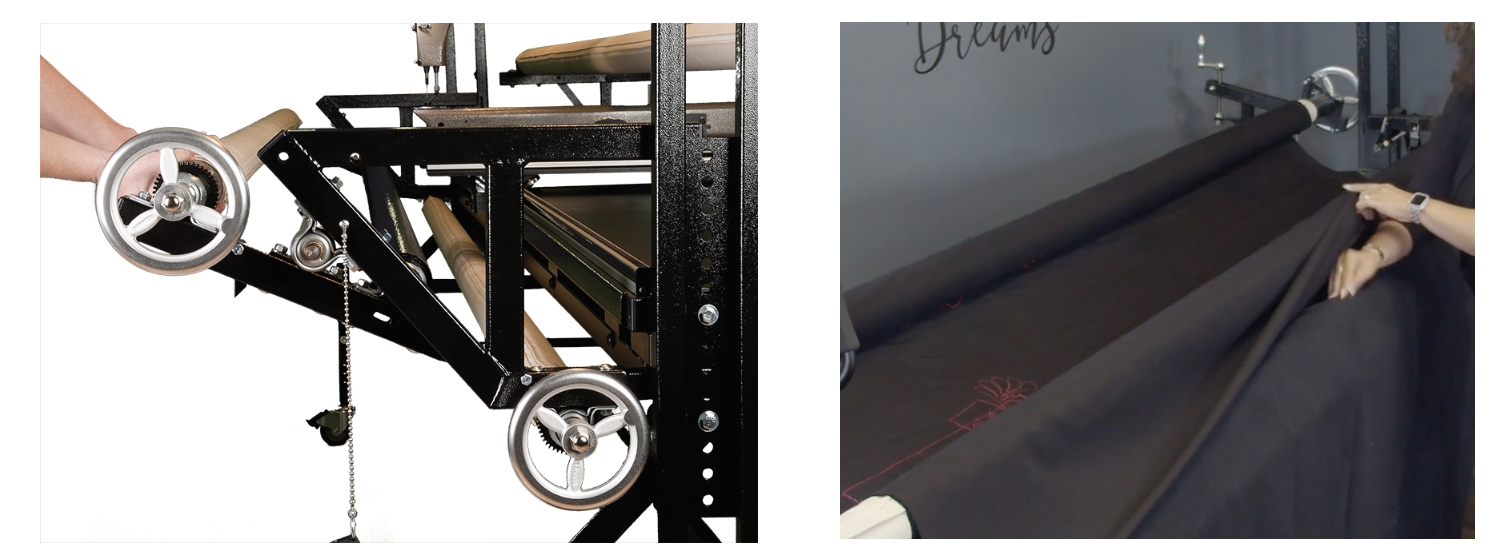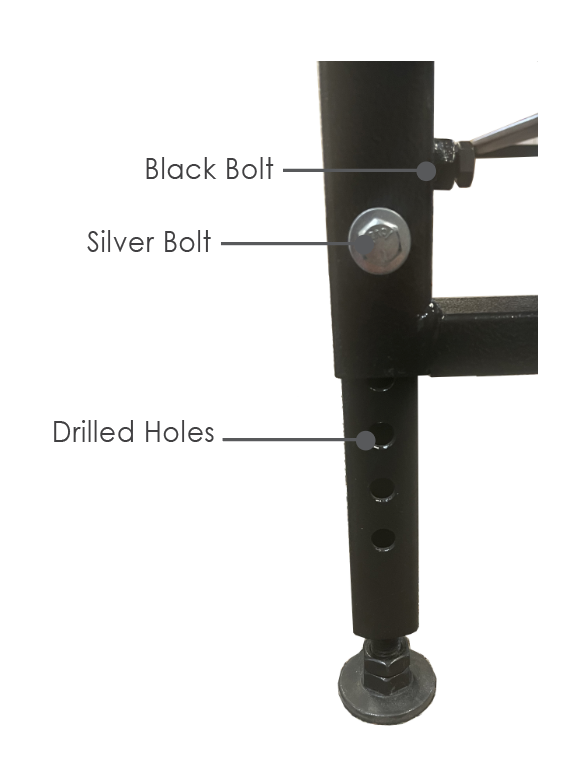Exploring and caring for the table
Learn to identify the parts of the Gammill GS Table with Pivotal Access and how to care for your table.

Parts of the Table
Pivotal Access Rod: This rod is located on the pivoting rod between the carrier and top rollers.
Pivotal Access Pin: This pin holds the pivotal access system in place during quilting. This pin is pulled out to allow the top roller and stabilizing bar to pivot for access to the batting.
Carrier Roller: Holds the quilt layers up and even with the pick-up roller during quilting. This is also referred to as the belly bar.
Pivotal Access Arm: On the pivotal access system, this arm holds the Carrier Roller, Top Fabric Roller, and the Stabilizing Bar.
Top Roller: Holds the quilt top for quilting.
Hand Wheel: Attached to one end of the pick-up, backing, and top rollers and used to quickly turn the rollers.
Backing Roller: Holds the backing fabric for quilting.
Pick-up roller: This bar holds the completed portion of the quilt during quilting. This roller is located inside the throat of the machine.
Pick-up roller hand crank: As the completed quilt is rolled onto the pick-up roller, the thickness of the completed quilt causes drag on the sewing head. Turn this crank to lift the pick-up roller off the sewing head for smoother movement.
Fabric leader: This thick canvas fabric is attached to the top, pick-up, and backing rollers. It is used to pin the quilt layers to the rollers.
Tracks: Set of two tracks used for holding and guiding the crosstrack along the length of the table. The crosstrack is the carriage that holds the machine head.
Tabletop: The tabletop can be a resting surface for supplies needed during the quilting process. Make sure nothing on the table interferes with the movement of the crosstrack.


Dog latch: The dog latch is a hinged latch that fits into a notch of the ratchet. When the dog latch is set in place, this allows the roller to only wheel forward as the quilt is advanced. To release the rolled fabric in order to load, unload, or adjust, simply flip the dog latch.
Pivotal Access Table
The pivotal access feature allows you to swing out and maneuver the frame. This makes loading a quilt and smoothing your batting much easier. The Pivotal Access Table is the standard table for all Gammill machines with a throat size of 22” or larger.
Tip: Before using the pivotal access feature, loosen the top and backing rollers for easy movement.

To use the pivotal access, remove the pivotal access release pin. You may wish to load the quilt with the pivotal access arm at a 90-degree angle. Move the arm to a 90-degree angle, align the pre-drilled holes of the table, and reinsert the pin to hold the arm at this angle.
Quilting is typically done with the arm at a 45-degree angle. This gives a space under the roller for the quilter to sit to quilt. In addition, this provides an ideal angle for the fabric to lay for the best quality stitches.

Fabric Leaders
The fabric leaders are thick canvas material affixed to the pick-up, backing, and top fabric rollers. You will notice that new leaders are stiff and it might be a little difficult at first to pierce the fabric with pins as you attach the fabric layers. Consider using corsage pins, which are long with a thick, strong shaft and hold up to the thicker canvas fabric. As you complete quilts you will notice less stiffness and the pins should be easier to place.
Note: Place pins 1/4” from the leader edge when pinning the quilt this extends the life of the leader edges.
Hand Wheels
Hand wheels are attached to the pick-up, backing, and top fabric rollers and are used to quickly and easily turn the rollers. The pick-up roller handle wheel also has a handle for even faster rolling. Hand wheels not only speed up the rolling process but they reduce repetitive motion in your wrists and hands.
Light Bar
The light bar is an optional equipment purchase. It can be attached to your machine table in order to provide additional overall light on your quilting space.
Pick-up Roller Hand Crank
As the quilt is completed and rolled onto the pick-up roller, it fills the area inside the throat. As the quilt becomes thicker around the pick-up roller it begins to create drag on the sewing head. This makes it difficult and sometimes impossible to move the machine. Your Gammill quilting system includes a one-step pick-up roller hand crank. You need only turn a crank on one side of the table to raise or lower the pick-up roller evenly across the table. The crank is located on the same side as the hand wheels. The distance between the pick-up roller and the sewing head should be the thickness of your hand.
Tip: If your machine is hard to move, check your pick-up roller /quilting machine clearance, and adjust as required.
Tip: If the quilt layers bounce as you quilt, the pick-up roller is too high. Turn the handle to lower the pick-up roller to the desired height.
Swivel Casters
This set of four, heavy-duty swivel casters are affixed to the legs of the table. If you need to move your machine around the room, these casters make it easy for one person to do the job. The casters do add about four (4) inches to the height of the table so you might need to adjust the table to the proper height for you. Two of the casters lock in position to prevent the table from rolling during quilting.
Adjusting the Table Height
The table legs include height and level adjustments. At the bottom of the legs you can set the  desired height by placing screws in predrilled holes. To make finer adjustments in height and/or to level the table, there is a level adjustment at the bottom of the leg. Turn the level adjuster until the desired height is reached.
desired height by placing screws in predrilled holes. To make finer adjustments in height and/or to level the table, there is a level adjustment at the bottom of the leg. Turn the level adjuster until the desired height is reached.
Cleaning the Carriage, Tracks, and Table
Dust, lint, and oil can fall onto the table, tracks, cross-track, and wheels. It is important to clean these areas daily to prevent the buildup of dust and lint.
Use a soft brush on the tracks on the table and cross-track. Other ways to clean inside the tracks are to use a vacuum cleaner, air compressor, or scraps of batting or fabric. It is important to clean the table area before a quilt touches it. Often this means that you need to clean the area before loading the quilt and again before unloading the quilt.
Leveling a Table with Hydraulics
Leveling a Table Without Hydraulics
How to check to see if your table is level and if not, level it. This is for a table without hydraulics.
